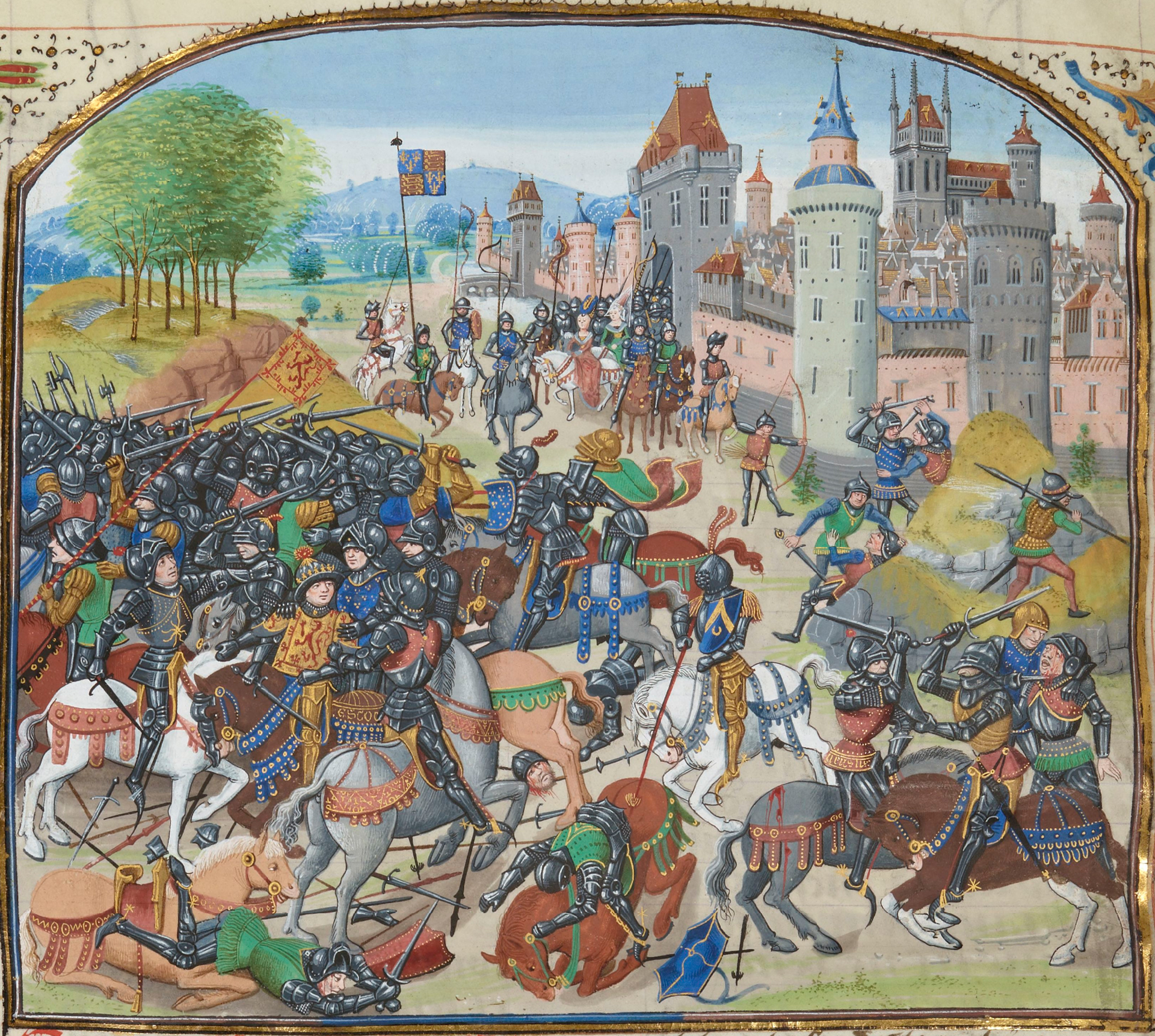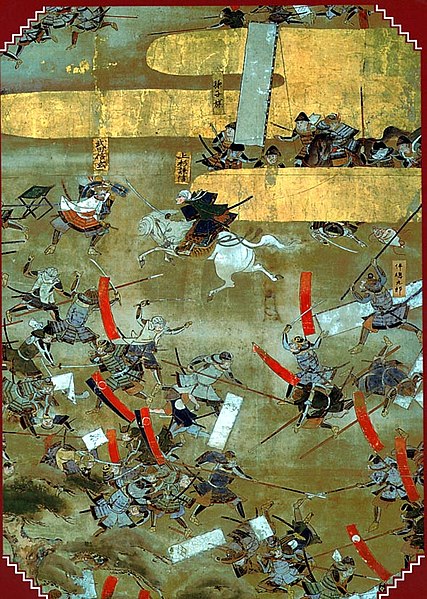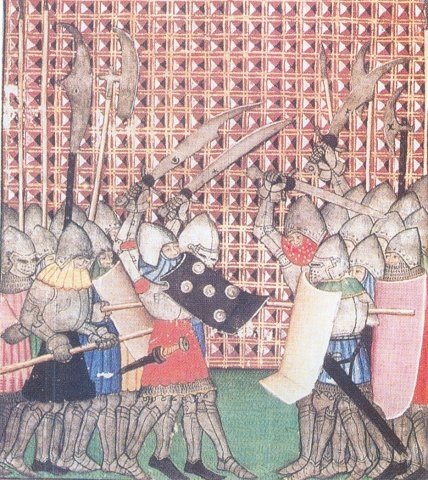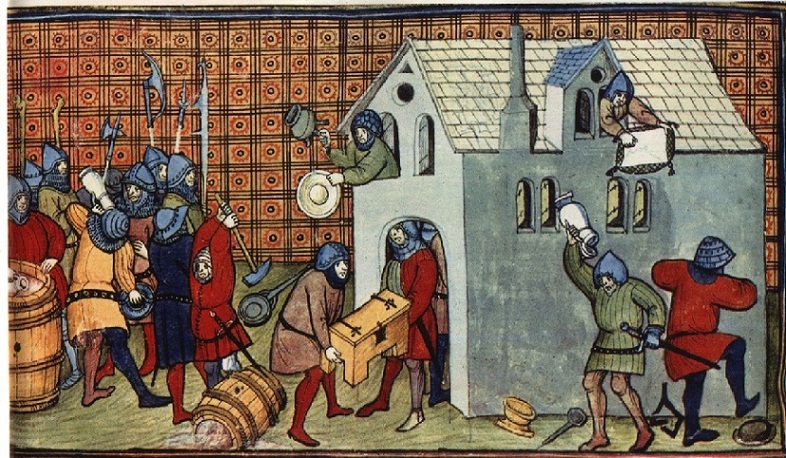| Author |
Message |
|
D. Graemer
Location: Düsseldorf Joined: 24 Mar 2013
Posts: 9
|
 Posted: Sun 24 Mar, 2013 4:51 pm Post subject: Medieval Infantry: Sword Usage Posted: Sun 24 Mar, 2013 4:51 pm Post subject: Medieval Infantry: Sword Usage |
 |
|
Did any medieval infantry use swords or similar weapons such as falchions or messer as primary weapons?
Popular culture and many wargames show "swordsmen" as an infantry type present in medieval armies. After some thinking, I find it rather hard to believe that swords were used as primary weapons.
In pitched battle, most infantry units prior to the invention of repeating firearms and machine guns would fight in close order formations. They provide a moral adventage as well as increased protection, concentration of force and the ability to resist cavalry charges. This said, infantrymen in the medieval period would wield a weapon that is usable when fighting in dense formations. The first weapon that comes to mind is the infantry spear. Spears were widespread weapons, cheap, easy to produce and suited to combat in formation. They can be used to stop infantry or cavalry charges, and rear ranks can still help due to the length of the spear. Also, they are useful because they help to stay in formation.
Of course, there are some situations where a sword would be more useful. The first-rankers, when in direct contact with the enemy shield-wall, may not be able to use their spears because of the confined space. Also, formation may break and a looser kind of combat may ensue. There might be difficult terrain or another situation that does not allow ordered formations. (climbing up ladders, fighting in woods or streets) So soldiers need a sword to be really effective. But the thing is: Everyone can carry a spear, a shield AND a sword. A man who can afford to buy a sword can buy a spear too. So I can see no reason why an infantry unit should be equipped with swords, but not with spears.
|
|
  |
 |
Robin Smith

|
 Posted: Sun 24 Mar, 2013 5:06 pm Post subject: Posted: Sun 24 Mar, 2013 5:06 pm Post subject: |
 |
|
I think the sword is analogous to the modern handgun. A symbol of rank and authority, a back-up weapon, and something that can be carried easily in public.
Art certainly depicts units of swordsmen on the battlefield, but using art in this way is fraught with problems. I have no doubt that many medieval battles had men who used a sword as their primary either due to circumstance or choice, but a unit of dedicated swordsmen doesn't make much sense to me.
Dopplesoldner and the like of course are an exception, but they have a specific role and I suspect that is not the type of "swordsmen" you are asking about.
A furore Normannorum libera nos, Domine
|
|
   |
 |
|
D. Graemer
Location: Düsseldorf Joined: 24 Mar 2013
Posts: 9
|
 Posted: Sun 24 Mar, 2013 5:48 pm Post subject: Posted: Sun 24 Mar, 2013 5:48 pm Post subject: |
 |
|
| Robin Smith wrote: |
Dopplesoldner and the like of course are an exception, but they have a specific role and I suspect that is not the type of "swordsmen" you are asking about. |
Yes. Doppelsöldner are something different, the "swordsmen" I mean are infantrymen with shield and arming sword/falchion/"short sword". (messer, baselard)
|
|
  |
 |
|
Timo Nieminen
|
 Posted: Sun 24 Mar, 2013 6:57 pm Post subject: Posted: Sun 24 Mar, 2013 6:57 pm Post subject: |
 |
|
Not the most common primary weapon, but it was done.
http://en.wikipedia.org/wiki/Rodeleros
"In addition to being efficient, all pole arms were quite nice to look at." - Cherney Berg, A hideous history of weapons, Collier 1963.
|
|
   |
 |
|
Christopher B Lellis
Location: Houston, Texas Joined: 01 Dec 2012
Posts: 268
|
 Posted: Mon 25 Mar, 2013 5:14 am Post subject: Posted: Mon 25 Mar, 2013 5:14 am Post subject: |
 |
|
I have wondered this myself and have done my own research.
From what I have seen researching medieval history, swords don't generally seem to be the primary weapon but there seem to be plenty of instances where all swords were unsheathed. Battles seemed to have started for the most part with bowman firing at the opposing side, infantry with spears or poleaxes and Calvary with lances. However, it seems that if one side didn't walk through the other side, and they got close, swords unsheathed everywhere.






High society dueling was definitely sword play.

Primary weapon or not, the sword does seem to have been heavily used in combat.
Last edited by Christopher B Lellis on Mon 25 Mar, 2013 4:24 pm; edited 1 time in total
|
|
  |
 |
|
Guy Bayes
Location: United States Joined: 07 Oct 2012
Posts: 64
|
 Posted: Mon 25 Mar, 2013 10:49 am Post subject: Posted: Mon 25 Mar, 2013 10:49 am Post subject: |
 |
|
|
Agree with the kinda like a handgun, caveat with the primary weapon was much much more likely to be damaged or lost then the rifle/pistol analogy would suggest
|
|
   |
 |
|
Christopher B Lellis
Location: Houston, Texas Joined: 01 Dec 2012
Posts: 268
|
 Posted: Mon 25 Mar, 2013 11:32 am Post subject: Posted: Mon 25 Mar, 2013 11:32 am Post subject: |
 |
|
For war purposes, the samurai seemed to prefer spears, bows and poleaxe type weapons as well.
I also agree with the handgun analogy.


|
|
  |
 |
|
D. Graemer
Location: Düsseldorf Joined: 24 Mar 2013
Posts: 9
|
 Posted: Mon 25 Mar, 2013 4:14 pm Post subject: Posted: Mon 25 Mar, 2013 4:14 pm Post subject: |
 |
|
@Timo: Rodoleros/Targetiers were used. As light infantry, it is reasonable that they do not carry spears. But why did they not use javelins combined with swords. Spain had a strong javelin-tradition, so it would seem natural.
@Christopher: Thanks for the pictures. I know that swords were used a lot in battle, when the fighting got close or the primary weapons were lost. But this is not usage as "primary weapons".
What is interesting is the 3rd picture. It shows a group of footmen with shield and sword only, albeit in a siege context.
edit: its the 4th picture, sorry
|
|
  |
 |
|
Timo Nieminen
|
 Posted: Mon 25 Mar, 2013 8:34 pm Post subject: Posted: Mon 25 Mar, 2013 8:34 pm Post subject: |
 |
|
| D. Graemer wrote: | | @Timo: Rodoleros/Targetiers were used. As light infantry, it is reasonable that they do not carry spears. But why did they not use javelins combined with swords. Spain had a strong javelin-tradition, so it would seem natural. |
So they don't have too much stuff to carry? So that they don't hang back from engaging in hand-to-hand fighting in order to throw some javelins?
They were usually only a small fraction of the army - there would be crossbowmen and musketeers to provide ranged attack. If they made up the bulk of the force, then there would be good reason to give them javelins or similar.
Chinese armies also used sword-and-shield men, again as a small part of the overall force (the dominant weapons being spear and bow/musket). Into the 19th century, tigermen with sword and shield were used as a screen to disrupt cavalry; they were considered elite forces. In late Ming, 2 sword-and-shield men were in the Mandarin Duck Formation, to protect the spearmen in case the enemy got past their points.
"In addition to being efficient, all pole arms were quite nice to look at." - Cherney Berg, A hideous history of weapons, Collier 1963.
|
|
   |
 |
|
Julian Behle
|
 Posted: Tue 26 Mar, 2013 12:55 am Post subject: Posted: Tue 26 Mar, 2013 12:55 am Post subject: |
 |
|
You are definetly right about spears and pikes. Scottish sheltrons were very famous for making good use of them. As far as I'm concerned as a 14th century enthusiast, the knightly weapons saw a tremendous decrease on the battlefield during that time. Lance charges failed often enough and swords weren't of that much use anymore against increasing plate armour. Swords were still the weapons of choice for a man of rank and not for display only, but battle got more nasty because you had to batter your oponent down, breaking the harness instead of slicing him into pieces or spike him at times of mail. Consequently a sword as an allround weapon gives you not the immense force in the thrust and cut and certainly not the blunt impact that you are required to inflict, if you want to prevail.
In the Hundred Years War, spears and pikes saw not really a decline in usage as they were more often kept in the rear ranks as did the sword by becoming a back up weapon. Hobelars and spearmen got outranked by archers. It was the same with the men at arms in England which symbolises the loss of status of the sword pretty good. What really won the battles were "heavy impact" weapons like maces, axes, flails, polearms and falchions (and of cause arballists). And by the time, many soldiers where no expert swordsmen anymore but commoners.
Combat also exadurated to dagger fighting, so you sometimes skipped over the sword as your back up weapon as well. Welsh knivemen often did the really dirty work by ripping up the horses bellies and making use of their agility to overwhelm men at arms as did the archers at Agincourt for example. The sword was not a weapon to finish someone with one stroke, though they got more pointy for piercing. Shortened lances or top-spiked axes are more handy in close quater fighting. In skirmishes it was a totally different matter. Swiss halberdiers developed a way to attack cavalry very affectively thus the weapon showed to be a great advantage at Sempach. So there was a tendency to polearms as well. No knight of the 13th century would have considered a poleaxe as a chivalrous weapon, later on it became standard in 15th century.
Infantry became more important in tactics. We can see that throughout the 14th century, though Italy is a bit of an exeption.
Especially in defence position, a sword is not of good use in tight formation, mid sized as it is. Although it is in no way totally nonsentical to have one but it's better kept sheathed until the formation opens.
The problem with illuminations is that when traditional "chivalrous" combat declined, it reached its apex in culture. Artists certainly had knowledge about what was going on on the battlefields, but it is obvious that heroic mass cavalry charges were not the tactic of choice as they where still displayed when the late middel ages were moving on. Symbolism and status of sword and lance kept going on to be too important to just leave them out on a picture but you see more and more "competition". It is therefore self-evident for me that the sword was not the best tool for an infantry soldier. As an every-day weapon it had its advantages but on the field of batte it was a distinctive weapon among others.
I have more pictures here. I just don't know how to several images in one post.
 Attachment: 98.96 KB Attachment: 98.96 KB

|
|
  |
 |
Benjamin H. Abbott

|
 Posted: Tue 26 Mar, 2013 5:39 pm Post subject: Posted: Tue 26 Mar, 2013 5:39 pm Post subject: |
 |
|
Writing well after medieval period, Sir John Smythe explained the sword's importance as follows:
| Quote: | | Swords of conuenient length, forme and substance, haue been in all ages esteemed by all warlike Nations, of al other sorts of weapons the last weapon of refuge both for horsemen, and footmen, by reason that when al their other weapons in fight haue failed them, either by breaking, losse, or otherwise, they then haue presentlie betaken themselues to their short arming Swords and Daggers, as to the last weapons, of great effect & execution for all Martiall actions. |
I'd say this resolves the contemporary unease surrounding the sword's status. Folks on forums such as this one commonly attempt to explain the perceived contradiction between the fact the warriors generally used other weapons first yet the sword gets the lion's share of the glory. According to Smythe, there's no contradiction: the sword wins esteem by being a secondary weapon! While you start the battle with lance, spear, or bow in hand, if it's hard-fought you end it wielding your sword and/or dagger. In this fashion, the sword signifies valor.
I remain somewhat puzzled by the relative lack of targetiers equipped with throwing weapons in the fifteenth and sixteenth centuries. In Mesoamerica, where the majority of Spaniards often fought as targetiers, I can't recall any reference to javelins as standard armament. Even when Maurice of Nassau explicitly attempted to revive the Roman way of war and tested targetiers against pikemen in mock battles, javelins are notably absent. Fourquevaux recommended placing a screen of targetiers armed with grenades in front the pikes for engaging opposing pike units, but it's unclear whether this ever happened much.
|
|
  |
 |
|
Timo Nieminen
|
 Posted: Tue 26 Mar, 2013 10:55 pm Post subject: Posted: Tue 26 Mar, 2013 10:55 pm Post subject: |
 |
|
| Benjamin H. Abbott wrote: |
I remain somewhat puzzled by the relative lack of targetiers equipped with throwing weapons in the fifteenth and sixteenth centuries. In Mesoamerica, where the majority of Spaniards often fought as targetiers, I can't recall any reference to javelins as standard armament. |
What fraction of the army was Spanish? While the targetiers may have been a large fraction of the Spanish part of the army, if the non-Spanish part of the army has plenty of slings and javelins, the Spaniards need not bother carrying such things.
Also, this is late enough so that one can ask how well javelineers will perform against musketeers.
"In addition to being efficient, all pole arms were quite nice to look at." - Cherney Berg, A hideous history of weapons, Collier 1963.
|
|
   |
 |
|
Antonio Ganarini
|
 Posted: Wed 27 Mar, 2013 4:37 am Post subject: Posted: Wed 27 Mar, 2013 4:37 am Post subject: |
 |
|
| Julian Behle wrote: | | I have more pictures here. I just don't know how to several images in one post. |
Hi Julian!
Thank you for the picture!
I'm interested in its source...
Ciao a tutti!
|
|
  |
 |
|
Luke Kramer
|
 Posted: Wed 27 Mar, 2013 7:31 am Post subject: Posted: Wed 27 Mar, 2013 7:31 am Post subject: |
 |
|
Interestingly enough I have used the "handgun analogy" for swords as well, and it works.
I do believe that swords were a little more effective against plate armor than has been suggested here, though. While it was certainly rare to see the sword as a primary weapon, there are many factors that keeps them usable on the battlefield throughout the Renaissance.
1.) They are (arguably) one of the most versatile weapons.
2.) As we move from the Late Middle Ages into the Early Modern, armor types varied significantly on the battlefield. Very few fighters on the battlefield were in full plate, leaving plenty of targets for a sharp sword.
3.) Even when confronted by an opponent in full plate, the design of the sword changed to exploit weaknesses in harnesses popular at the time.
4.) Many of the harnisfechten techniques (such as the mortschlage) are particularly effective against plate armor.
Again, I fully agree that the sword's time was waning, but I think that it remained a little more useful than has been suggested. ; an excellent sidearm for those who could afford it.
Castlerock Museum School and Group Coordinator
Wisconsin Historical Fencing Association (WHFA)
|
|
  |
 |
Benjamin H. Abbott

|
 Posted: Wed 27 Mar, 2013 7:41 am Post subject: Posted: Wed 27 Mar, 2013 7:41 am Post subject: |
 |
|
| Timo Nieminen wrote: | | What fraction of the army was Spanish? While the targetiers may have been a large fraction of the Spanish part of the army, if the non-Spanish part of the army has plenty of slings and javelins, the Spaniards need not bother carrying such things. |
Depending on the exact point in time, Bernal Diaz and company had as many as thousands of Tlaxcalan and other Mesoamerican allies. Those troops may have carried slings, bows, and atlatls, though details remain fuzzy despite the great numbers involved. Regardless, neither Diaz nor Cortes make any mention of rodeleros hurling javelins at any point that I recall. Sword, shield, and armor, on the appear repeatedly, especially in Diaz. One thing I've thought was the close order employed by rodeleros made hurling javelins impractical. Diaz wrote about standing shoulder to shoulder with his fellows during battle. In the European field, advance targetiers - such as the ones Fourquevaux described - would have been in loose enough formation to throw admirably, but it's unlikely that javelins could have accomplished much against the typically well-armored front ranks of an opposing pike formation. In that case it's possible they just weren't worth the trouble. It's also possible that skill in throwing javelins had declined. These two factors could have mutually reinforcing.
| Quote: | | Also, this is late enough so that one can ask how well javelineers will perform against musketeers. |
Not terribly well, judging by English accounts of Irish darts in the sixteenth and early seventeenth century. But the Spanish didn't have to worry about muskets from their Mesoamerican foes.
|
|
  |
 |
Michael Curl

Location: Northern California, US Joined: 06 Jan 2008
Posts: 487
|
 Posted: Wed 27 Mar, 2013 9:22 am Post subject: Posted: Wed 27 Mar, 2013 9:22 am Post subject: |
 |
|
Could you link me to some of these sources regarding the Irish darts vs. English troops? I am very interested.
E Pluribus Unum
|
|
   |
 |
Benjamin H. Abbott

|
 Posted: Wed 27 Mar, 2013 10:50 am Post subject: Posted: Wed 27 Mar, 2013 10:50 am Post subject: |
 |
|
John Dymmok is one source. Here is a nineteenth century reprint. See page 7-8 for a description of Irish warriors. Also see Fynes Moryson (search for darts).
Going back to the original question, the sword's place depends on the period and location in question. In thirteenth-century Scandinavia, a spear was apparently worth two swords when fighting on foot with shields. However, at least by early sixteenth century and into the seventeenth, you see units of targetiers with swords but no or few spears.
Greek hoplites: Spear and large shield with a short sword for backup
Roman legions: Javelin(s), short sword, and large shield
Medieval Scandinavia infantry: spear and shield with a sword for backup
16th- & 17th-century targetiers: just sword and shield
There's no clear progression here; presumably each combination made sense within its context. Various styles coexisted, particularly in ancient times, when the shield dominated. Additionally note that shield and sword was a popular combination for assaulting fortifications judging by medieval artwork and later Renaissance-era practice. One theory is that the Spanish preference for sword and shield came out of the siege warfare involved in the Reconquista. This makes sense to me; particularly when storming a tower, a sword seems superior to a spear because of the potentially confined circumstances.
|
|
  |
 |
|
Julian Behle
|
 Posted: Thu 28 Mar, 2013 11:29 am Post subject: Posted: Thu 28 Mar, 2013 11:29 am Post subject: |
 |
|
| Antonio Ganarini wrote: |
Hi Julian!
Thank you for the picture!
I'm interested in its source... |
It's from Italy, late 14th century. I actually don't know precisely where I got it from. Down here are some links and more pictures, where you can find what you are searching for. It should be among many others in these galleries.
You can make use of the search function by using several key words down the pages. The Italian frescos and illuminations in there are especially useful.
http://www.agefotostock.com/age/ingles/iskw01...amp;Page=1
http://www.agefotostock.com/age/ingles/iskw01...amp;Page=1
http://vasco.io.ua/album393648
http://vk.com/photo-11029306_261866984
One more word about the topic. It is true that you had more space in a siege after you entered a town or castle because fighting in close formation was not very easy and practical. On the ramparts you needed breaking weapons. As I sad, an axe or a mace is of course much more practical than a spear. Although swords developed and got more pointy, this is not the entire answer to full plate in a batlle, in a skirmish or a trial by combat certainly, but not when it comes to close quater fighting regardless of high flexibility and fencing skills. The sword was a sencodary weapon, a reliable all rounder as the dagger was as well, but not for the very "crucial" first stroke.
 Attachment: 231.37 KB Attachment: 231.37 KB

soldiers with both swords and polearms
|
|
  |
 |
|
Augusto Boer Bront
Industry Professional
Location: Cividale del Friuli (UD) Italy Joined: 12 Nov 2009
Posts: 296
|
|
   |
 |
Dan Howard

|
 Posted: Thu 28 Mar, 2013 4:01 pm Post subject: Posted: Thu 28 Mar, 2013 4:01 pm Post subject: |
 |
|
| Benjamin H. Abbott wrote: | | Roman legions: Javelin(s), short sword, and large shield |
This seems limited to specific circumstances. When on the offensive in open terrain they would have thrown the pilum to break up the formation before wading in with their swords. However, when on the defensive they closed ranks and used the pilum as a thrusting spear in a typical shield wall formation. When in rough terrain the auxilliaries seem to have done most of the fighting.
|
|
  |
 |
|
|
You cannot post new topics in this forum
You cannot reply to topics in this forum
You cannot edit your posts in this forum
You cannot delete your posts in this forum
You cannot vote in polls in this forum
You cannot attach files in this forum
You can download files in this forum
|
All contents © Copyright 2003-2024 myArmoury.com — All rights reserved
Discussion forums powered by phpBB © The phpBB Group
Switch to the Basic Low-bandwidth Version of the forum
|

